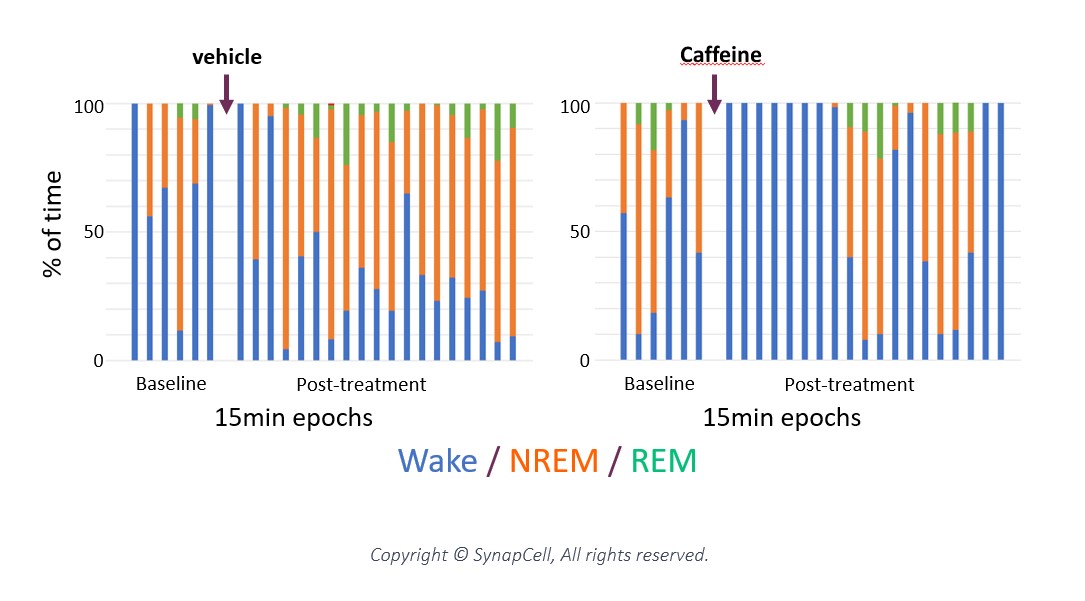Sleep AND Vigilance States
Home » Solutions / Preclinical EEG Services / Preclinical Assays / Sleep & Vigilance States
How the Study of Sleep and Vigilance States Helps Characterize Compound Effects and Guide CNS Drug Discovery
The study of changes to sleep and vigilance states can be the key to understanding brain alterations for many CNS conditions; when developing a compound, it is also crucial to know how it modulates the different stages. Characterizing the effects of pharmacological compounds on sleep and/or altered sleep architecture, using advanced qEEG and polysomnography, is therefore a key feature of preclinical studies into CNS diseases, particularly for neurodegenerative (Parkinson’s diseases, Alzheimer’s, etc.) and neuropsychiatric disorders (Schizophrenia, Anxiety, Depression, etc.).
A Comprehensive Range of Solutions to Analyze Sleep and Vigilance States
SynapCell offers a complete range of solutions to study the impact of compounds on sleep and vigilance states. Choose the most appropriate option to fit your needs and required readouts: comprehensive overview of sleep architecture, advanced qEEG with insights into sleep and vigilance states, or the complete solution combining both options.
1. Sleep Architecture
Sleep architecture analysis examines the structure and patterns of sleep stages using tools like polysomnography or EEG recordings.
Readouts: data on sleep fragmentation (duration and sequence of NREM and REM sleep cycles), REM and NREM onset times, % time spent in each state, etc.
2. Advanced qEEG for Sleep and Vigilance States
This comprehensive solution includes sleep architecture readouts plus advanced qEEG analyses of sleep and three vigilance states. It offers a more in-depth picture of how the compound affects sleep-wake cycles and various states of vigilance.
Readouts: sleep architecture readouts + spectral analysis for each sleep and vigilance state (wake, REM, NREM).
We combine the power of preclinical EEG (Electroencephalography) and EMG (Electromyography) to accurately identify vigilance states in animal models and fully characterize your compound. EEG and EMG electrodes are implanted to analyze vigilance states: Wakefulness, REM (Rapid-Eye Movement), and NREM (Non-REM).
Diving into Sleep Architecture
Sleep disorders are a common feature of several neurodegenerative and neuropsychiatric diseases. To assess the impact of your molecule, SynapCell offers a comprehensive understanding of Sleep Architecture, providing detailed readouts that track sleep fragmentation, including the frequency of each sleep state, onset times for REM and NREM states, and the percentage of time spent in each state.

A High Level of Expertise Enhanced by AI-Powered Analysis
We use Machine Learning to save time, increase efficiency, and enhance reliability. As a result, our analyses are not only human-dependent. Nevertheless, all analyses are reviewed and enriched by our team of experts, drawing on their solid know-how and expertise.

Model Phenotyping and Exploration
The impact of genetic manipulations on sleep–wake dynamics can offer important insights into the intricate mechanisms underlying pathological development. SynapCell’s capabilities can be used to phenotype an existing model or to characterize new models with specific sleep and wakefulness characteristics.

Early-Stage EEG Insights
As sleep deficits are frequently associated with the prodromal phase of central CNS disorders (e.g. Huntington’s, Parkinson’s, Alzheimer’s), they can serve as an early indicator of disease onset, which can be used to assess compound efficacy on wake, REM, and non-REM states thanks to early EEG biomarkers.
Get Additional Insights into Sleep and Vigilance States with Advanced qEEG
Advanced qEEG provides detailed EEG spectral analysis for the three sleep and vigilance states: Wakefulness, REM (Rapid-Eye Movement) and NREM (Non-REM) sleep. Data can then be compared against a comprehensive pharmacological reference database of well-characterized compounds, to allow accurate profiling and assessment of the test-molecule’s pharmacological signature.
Translational and Predictive Readouts

EEG State-Dependent Fingerprint of your Compound
Wake, NREM, and REM states have distinct EEG patterns. We analyze the EEG spectrum of your compound to characterize its EEG signature for these 3 states. It can then be validated against an extensive pharmacological reference database.

Detection of Potential Associated Effects on Sleep and Wakefulness
SynapCell’s advanced qEEG accurately measures a compound’s impact on Wake, NREM, and REM states, contributing to revealing any unforeseen effects on sleep and vigilance, whether beneficial or adverse.
Key Features of Sleep and Vigilance Capabilities
Our approach integrates an advanced Machine Learning algorithm to streamline data processing, enhancing both speed and accuracy. This automated analysis also reduces human bias.
However, we don’t rely on the machine alone. Our team of seasoned experts thoroughly reviews each output, applying their extensive scientific knowledge to verify the accuracy and validity of the results, ensuring the highest quality insights.
Our translational approach links the preclinical and clinical development phases using EEG, a powerful predictive translational tool. The effects of a compound on EEG signal are mirrored from rodent to human.
SynapCell’s sleep and vigilances states capabilities are validated by comparison to an extensive pharmacological reference database:
- Awakening: modafinil, caffeine
- Hypnotic: zolpidem, diazepam
- Affecting REM state: surovexant
- Procognitive: donepezil
The preclinical results generated by Cue®, our predictive and translational in vivo EEG platform, are in line with the scientific literature, demonstrating that SynapCell’s preclinical EEG solutions provide reliable translational results.
Drug Discovery Assays with Sleep & Vigilance Capabilities
Dose-response assays evaluate how biological systems react to varying drug concentrations. The resulting dose-response curve provides vital information on drug potency, efficacy, therapeutic range, and safety, guiding crucial decisions in drug development.
Pharmacodynamics provides detailed information on how a compound interacts with the brain, for example, by measuring a compound’s effects over time, its mechanisms of action, or the relationship between drug concentration and EEG modulation.
Identify, optimize and test compounds with promising efficacy profiles or pharmacological properties to determine their true potential as drug candidates.
Assess your compound’s potential to modify disease symptoms. Sleep disruption is part of the prodromal phase of many CNS diseases.
Sleep architecture and advanced qEEG with sleep and vigilance insights can be used to explore and characterize new models for which these specificities are key.
POSTER
Assessing Sleep Architecture and Pharmacodynamics: An EEG-Based Platform for Drug Testing
In this study, we developed an analysis pipeline using an in-house EEG platform focused on sleep architecture to test the effects of drugs on vigilance states and the corresponding pharmacodynamic modulations of frequency bands for each state, i.e. wakefulness, rapid eye movement (REM) sleep and non-rapid eye movement (NREM) sleep. This new analysis pipeline provides a tool to more rapidly and objectively assess the effects of compounds in development and compare them to reference drugs for various indications.
DOWNLOAD
POSTER
DOWNLOAD
POSTER
POSTER
Standardized Pharmaco-Sleep-Electroencephalography as a Preclinical Tool for Antidepressant Drug Profiling
In this study, we hypothesized that drug-effects may be expressed differently depending on the vigilance state during recording sessions. We proposed automatic state-detection (Machine Learning approach) as a viable tool to estimate state-induced effects of drugs. We evaluated this method for the assessment of the dose-dependency of antidepressants with distinct mechanisms of action: Fluoxetine and Maprotiline in wild-type C57BL/6J mice.

Powered by Cue®, SynapCell's Predictive In Vivo EEG Platform
SynapCell’s rodent models and their associated EEG biomarkers are processed on Cue®, our innovative translational in vivo EEG platform, which is designed to predict the in-human efficacy of your drug candidates during the preclinical step. Cue® is the result of decades of R&D, combining SynapCell’s know-how, expertise and scientific excellence in the fields of brain surgery and EEG signal recording, processing, and analysis.
Using Cue®, we transform preclinical data into actionable insights, offering end-to-end support for informed decision-making in CNS drug discovery.
THE SCIENCE CORNER
Sleep Architecture: Characterization of Caffeine
Caffeine has a well-known pro-wakefulness effect, with increased time spent in the Wake state after administration. Caffeine also increases the onset time for REM and NREM sleep.
Let's Talk About Your Research Project!
More than a CRO, a team of collaborators – we are your dream neuroscience team specialized in preclinical EEG! We don’t just produce data, we are your partners from conceptualization to conclusion. We translate raw EEG data into meaningful, clinically-relevant endpoints, delivering clear insights to allow data-based decision-making. Choose SynapCell, a leading preclinical CNS-specialized CRO for cutting-edge EEG expertise combined with an irresistible touch of fun.
News & Events
PRESS RELEASE
SynapCell and the University of Utah Celebrate the 10-year Anniversary of their Collaboration on Anti-Seizure Medications.
NEW!
AMYGDALA KINDLING MODEL
Choose our Amygdala Kindling model to test compounds targeting focal-to-bilateral tonic-clonic seizures. Choosing the right model for the appropriate type of epilepsy seizures is key to the effective discovery of ASMs.
NEW!
SLEEP & VIGILANCE STATES
Discover SynapCell’s new preclinical EEG capabilities for sleep and vigilance states, and gain additional insights to characterize compound effects.




